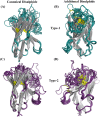Discrete analysis of camelid variable domains: sequences, structures, and in-silico structure prediction
- PMID: 32185102
- PMCID: PMC7061911
- DOI: 10.7717/peerj.8408
Discrete analysis of camelid variable domains: sequences, structures, and in-silico structure prediction
Abstract
Antigen binding by antibodies requires precise orientation of the complementarity- determining region (CDR) loops in the variable domain to establish the correct contact surface. Members of the family Camelidae have a modified form of immunoglobulin gamma (IgG) with only heavy chains, called Heavy Chain only Antibodies (HCAb). Antigen binding in HCAbs is mediated by only three CDR loops from the single variable domain (VHH) at the N-terminus of each heavy chain. This feature of the VHH, along with their other important features, e.g., easy expression, small size, thermo-stability and hydrophilicity, made them promising candidates for therapeutics and diagnostics. Thus, to design better VHH domains, it is important to thoroughly understand their sequence and structure characteristics and relationship. In this study, sequence characteristics of VHH domains have been analysed in depth, along with their structural features using innovative approaches, namely a structural alphabet. An elaborate summary of various studies proposing structural models of VHH domains showed diversity in the algorithms used. Finally, a case study to elucidate the differences in structural models from single and multiple templates is presented. In this case study, along with the above-mentioned aspects of VHH, an exciting view of various factors in structure prediction of VHH, like template framework selection, is also discussed.
Keywords: Antibodies; Complementarity determining regions; Frameworks; Nanobodies; Secondary structure; Sequence structure relationship; Structural alphabet.
©2020 Melarkode Vattekatte et al.
Conflict of interest statement
Frederic Cadet is associated with PEACCEL, Paris, France. Jean-Christophe Gelly and Alexandre G. de Brevern are associated with IBL, Paris, France. Jean-Philippe Meyneil is employed by ISoft, Paris, France. Alain Malpertuy is employed by Atragene, Paris, France. Nicolas K. Shinada is sponsored by Discngine, Paris, France and ANRT, France. All other authors declare no competing interests.
Figures







Similar articles
-
General Trends of the Camelidae Antibody VHHs Domain Dynamics.Int J Mol Sci. 2023 Feb 24;24(5):4511. doi: 10.3390/ijms24054511. Int J Mol Sci. 2023. PMID: 36901942 Free PMC article.
-
Insights into Comparative Modeling of VHH Domains.Int J Mol Sci. 2021 Sep 9;22(18):9771. doi: 10.3390/ijms22189771. Int J Mol Sci. 2021. PMID: 34575931 Free PMC article.
-
Structural Classification of CDR-H3 in Single-Domain VHH Antibodies.Methods Mol Biol. 2023;2552:61-79. doi: 10.1007/978-1-0716-2609-2_2. Methods Mol Biol. 2023. PMID: 36346585
-
VHH Structural Modelling Approaches: A Critical Review.Int J Mol Sci. 2022 Mar 28;23(7):3721. doi: 10.3390/ijms23073721. Int J Mol Sci. 2022. PMID: 35409081 Free PMC article. Review.
-
Applications and challenges in designing VHH-based bispecific antibodies: leveraging machine learning solutions.MAbs. 2024 Jan-Dec;16(1):2341443. doi: 10.1080/19420862.2024.2341443. Epub 2024 Apr 26. MAbs. 2024. PMID: 38666503 Free PMC article. Review.
Cited by
-
Evaluation of the Potential Impact of In Silico Humanization on VHH Dynamics.Int J Mol Sci. 2023 Sep 26;24(19):14586. doi: 10.3390/ijms241914586. Int J Mol Sci. 2023. PMID: 37834033 Free PMC article.
-
General Trends of the Camelidae Antibody VHHs Domain Dynamics.Int J Mol Sci. 2023 Feb 24;24(5):4511. doi: 10.3390/ijms24054511. Int J Mol Sci. 2023. PMID: 36901942 Free PMC article.
-
Structural Insights into the Stability and Recognition Mechanism of the Antiquinalphos Nanobody for the Detection of Quinalphos in Foods.Anal Chem. 2023 Aug 1;95(30):11306-11315. doi: 10.1021/acs.analchem.3c01370. Epub 2023 Jul 10. Anal Chem. 2023. PMID: 37428097 Free PMC article.
-
Application of recombinant antibodies for treatment of Clostridioides difficile infection: Current status and future perspective.Front Immunol. 2022 Aug 23;13:972930. doi: 10.3389/fimmu.2022.972930. eCollection 2022. Front Immunol. 2022. PMID: 36081500 Free PMC article. Review.
-
Site-specifically radiolabeled nanobodies for imaging blood-brain barrier penetration and targeting in the brain.J Labelled Comp Radiopharm. 2023 Dec;66(14):444-451. doi: 10.1002/jlcr.4069. Epub 2023 Oct 24. J Labelled Comp Radiopharm. 2023. PMID: 37873934 Free PMC article. Review.
References
-
- Ablynx Ablynx 2016 Annual report 2016
LinkOut - more resources
Full Text Sources
Other Literature Sources

